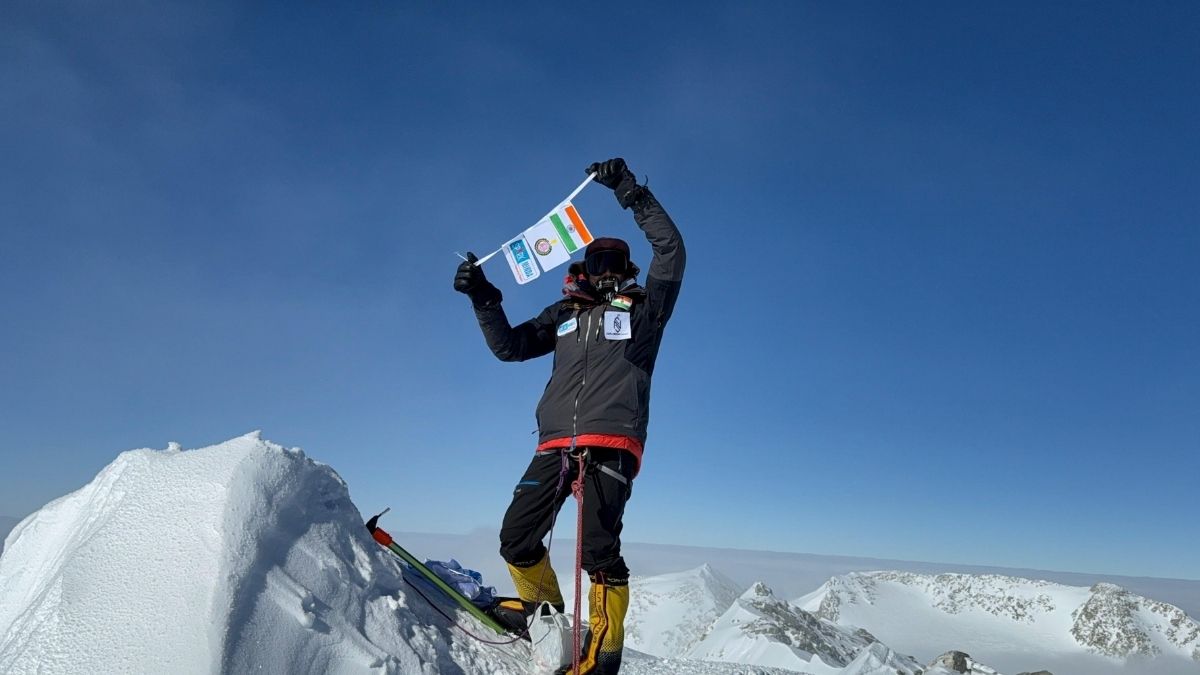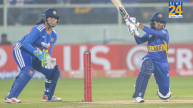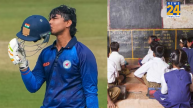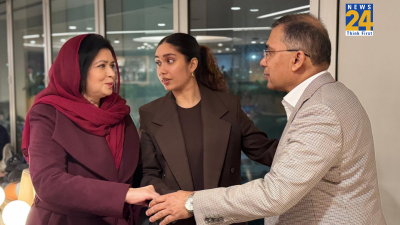Narender Singh Yadav made history by becoming the youngest male mountaineer from India to conquer the highest peaks on all seven continents. He broke this record at the age of 30 years and 10 days. Narender Singh Yadav hoisted the Indian flag atop Vinson Massif, Antarctica’s highest peak, on December 25 at 1:42 am IST, when the temperatures were as low as -52°C. He has earned the prestigious title of “World Emperor” from renowned global record institutes, reportedly boasting an impressive 22 world records in mountaineering.
In an exclusive interview with News24’s Akshat Mittal and Saksham Nagar, mountaineer Narender Singh Yadav, currently in Antarctica, had a conversation from a temperature of minus 50 degrees. He shared his mountaineering experiences, challenges, and most daunting moments, including his harrowing encounters with dead bodies during his Mt. Everest summit.
Narender Singh Yadav Interview: Excerpts
Question: Who ignited your passion for mountaineering?
- “I was inspired to take up mountaineering by my relative, Santosh Yadav, who climbed Everest twice. My father was in army and his experiences in Siachen also motivated me. I attempted to climb Everest three times. Unfortunately, my first two attempts in 2014 and 2015 were cancelled due to accidents and an earthquake. But I finally succeeded in 2016! After that, I continued to push myself and eventually completed the 7 Summits challenge.”
Q: There was some controversy surrounding your 2016 Everest climb, with questions raised about the legitimacy of your attempt. Can you share your side of the story?
- “I’d like to clarify the controversy surrounding my 2016 Everest climb. After reaching Camp 2, I donated my sleeping bag for a rescue mission and slept in wet socks, resulting in frostbite. I was hospitalized and later received my certificate, but my team leader withheld my camera’s memory card, which had crucial photos and videos.”
- “Years later, in 2020, I received the Tenzing Norgay National Award, but my team leader photoshopped and shared those photos and videos on social media, sparking controversy. Nepal banned me for 10 years from doing any kind of adventure activity, but I fought the decision in court and had the ban lifted.”
- “I went on to climb Everest again, setting a world record by completing the summit in just six days without acclimatization.”
Question: What was the most challenging moment in your 7 Summits journey, and which mountain posed the greatest challenge?
- “Every mountain has its unique challenges, weather, and environment, making each one difficult in its own way. I consider every mountain, regardless of height, to be as challenging as Mt. Everest. For example, some people who climbed Everest struggled with smaller peaks like Kilimanjaro, Vinson, or Denali.”
- “Personally, I enjoyed climbing Denali, located in Alaska. In fact, Denali is a mountain that makes me feel like I’m truly climbing.”
Q: How has the central government and Haryana government supported you in your mountaineering career?
- “I got immense support from both the state and central governments. Additionally, I was fortunate to have sponsors for all my expeditions. Some notable sponsors include Spark Minda, M2K, IPL Biological, Honda 2 Wheelers, and Minda Industries, led by Nirmal Minda. Their support was invaluable, and I appreciate their contribution to my mountaineering journey.”
Question: What’s your plan for completing the Adventure Grand Slam, which includes the South Pole and North Pole?
- “Actually, this is the part of my plan. My next targets are the North Pole and South Pole. I’ll start with the North Pole and South Pole next year, since it’s the right season. So, I have a whole year to prepare. After that, I’ll complete both the North and South Poles, and achieve the title of Adventure Grand Slam.”
Question: What challenges do you face in securing sponsorships as a mountaineer?
- “Securing sponsorships as a mountaineer can be challenging. Initially, I relied on my family’s savings, but later, reputable companies sponsored me. My father, an Indian Army soldier, sacrificed his savings to support my dreams. Additionally, my mother made significant contributions, managing household expenses by stitching suits in Rs 5-7 of the people and using my father’s salary to fund my mountaineering courses.”
- “To attract sponsors, it’s crucial to create a strong project report highlighting what sets your expedition apart and the benefits it offers. Companies want to know why they should invest in you.”
- “For instance, it required Rs 60–62 lakh in my Vinson expedition, a substantial amount even for a large company. This raises a valid question: what value can I offer to justify such a significant investment? The answer lies in creating a strong project report that highlights how I plan to make the expedition unique and impactful.”
- “In India, sponsorship opportunities do exist, but it’s essential to approach the right companies with a well-crafted project report, a realistic budget, and a clear understanding of the value you can offer. Many project rejections stem from a lack of preparation and unrealistic expectations.”
- “My advice to aspiring mountaineers is to prioritize building your career and skills first, rather than focusing solely on earning money. With a strong foundation, you’ll have ample opportunities to secure sponsorships and funding for your expeditions.”
Q: How did it feel to be so close to the Tenzing Norgay Award, but not quite reach it? What do you think about that now?
- “Receiving the Tenzing Norgay Award was bittersweet for me. Just as I was about to accept the honor, I was informed that my award was being withheld due to an inquiry. This devastating news coincided with a personal tragedy – my father’s kidneys failed, and my mother was in shock. It was an unbearable time, but I credit my faith and supportive loved ones for helping me endure it.”
- “Frankly speaking, now I don’t think about the Tenzing Norgay Award, as I’ve already received it in 2020 but was withheld because of a conspiracy. I stand by my achievement. The award can be temporarily withheld, but my pride in earning it can never be taken away. I will always hold my head high.”
Question: We saw a video of you climbing a Mt Everest with dead bodies on the route. What does it feel like to climb a mountain and come across dead bodies along the way?
- “There’s a “dead zone” on Mt. Everest, after K4, where many bodies are found. As you approach the summit from K4, you’ll encounter several dead bodies along the way. You may have heard of the “green boots” or the yellow dungarees used for route marking.”
- “The video you saw was when I was descending from the Hillary Steps. There was a body right next to the rope. During my climb, I’ve seen at least 8–10 bodies like that. These were likely mountaineers who were attempting to summit Everest but didn’t make it.”
- “The reasons for these deaths are often lack of oxygen, exhaustion, injuries, or accidents. Sometimes, climbers slip because they can’t properly secure their carabiners to the rope, or they fall due to fatigue. Oxygen runs out, or they just stop due to extreme tiredness. It can be mentally challenging, but you have to find a way to cope with it.”
Question: What are the two most important basics to keep in mind while training for mountaineering?
- “To be a successful mountaineer, you need to be technically, mentally, and physically strong. It’s crucial to have the necessary skills to survive and ensure a safe return. I’m speaking from experience, having completed various courses before starting my mountaineering journey. My advice is to prioritize taking courses, gaining knowledge, and developing your skills.”
Question: What mountaineering courses are available in India, and where can one pursue them?
- “There are four main mountaineering courses: Basic Mountaineering Course, Advanced Mountaineering Course, Search and Rescue, and Method of Instruction (MOI). These courses are offered by several government-run institutes, including NIM (Nehru Institute of Mountaineering) in Uttarkashi, HMI (Himalayan Mountaineering Institute) in Darjeeling, ABMS (Atal Bihari Vajpayee Institute of Mountaineering and Allied Sports) in Manali, and NIMAS (National Institute of Mountaineering and Allied Sports) in Jodharang, among others.”
ALSO READ: ‘Urban Naxal’ To ‘Mountain Man’: Meet Chhattisgarh’s Rahul Gupta, Who Conquered Mt Everest













